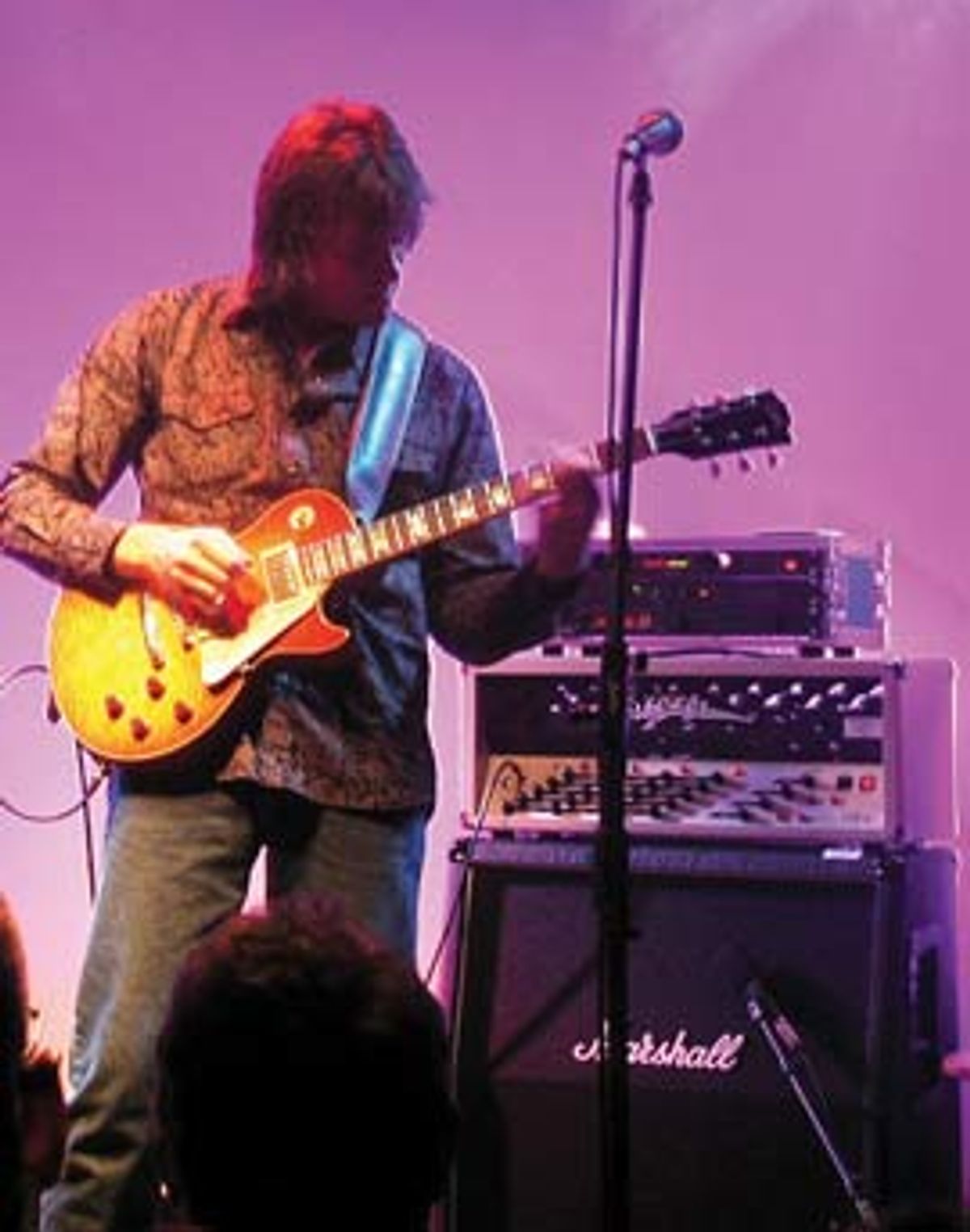
With comparisons to Steve Morse and highly-acclaimed concept albums, German guitarist Tom Riepl is a name you should know.
When you play instrumental guitar rock, chances are people will put you in that Satriani/Vai/Morse etc. niche. In the case of German guitarist Tom Riepl, such comparisons might actually be pretty inappropriate. Years ago, Riepl's guitar playing was frequently compared to Steve Morse's style. It could be interpreted as a compliment on the one hand, but it could be seen as a kind of obstacle on the other, because the 47-year-old Riepl simply wants to be seen as an original guitarist who’s absorbed various genres and influences into his own individual style. According to fans, prominent fellow musicians and critics alike, his style is certainly recognizable. It's an engaging mixture of rock, blues, jazz, country and TV show soundtrack. And even though Riepl’s compositions can hardly be ascribed to any single style of music, they all have one thing in common: his unmistakable way of combining complex chords, melodies and improvisations while making it appear relaxed, easy and catchy.
Riepl has mastered the most difficult challenge in instrumental rock: never letting an album without a singer become boring! What’s more, his recent CDs are concept albums in the true sense of the word. Hollymood seems to be a real road movie—or better, an ear movie… without pictures, but with lots of hot, rockin’ guitar themes in a hilarious send-up of the movie business. The counterpart to Hollymood (which won “best instrumental guitar album of the year” for 2002 in Germany’s Musikexpress magazine) is Riepl’s latest album Radio Moonlight, which is all about an imaginary radio station playing guitar instrumentals on a calm summer night.
Riepl actually started with the blues before he left his rural hometown and went to Munich in order to study guitar. Since then, he’s done it all: teaching, clinics, composing music for theatre and radio plays, working as a session player and touring as a sideman. He also writes and records his own music and has a regular column in the German magazine, Gitarre & Bass. Riepl was the first German guitarist to be honored with a signature guitar by Ibanez, he recently introduced his brand-new signature overdrive pedal, the GAS-809 Tomtone (by German manufacturer Rodenberg) and is an endorser for Carvin guitars at present. After almost 25 years of ups and downs in a crazy business, the guy is still around and doing well. What’s his secret? Riepl didn’t put the cart before the horse; he did it step by step, and still does.
What was your first guitar, and do you still own and play it?
My first guitar was a small acoustic nylon-string made by (German manufacturer) Klira. I got it in 1973, and it cost 135 German Marks, which was approximately $32 back then. I still own it and yes, I still play it occasionally.
Do your remember your first gig?
I think it was around 1977, in the schoolyard of my former high school. I was new in that band, and we played some strange kind of hippie-punk-blues-rock, including long improvisation parts. Nowadays you would call this a jam band. I played a Framus guitar through some cheap wah/distortion pedal and an Italian-made GEM amp.
What are your most important influences in music?
It all started with the blues! My cousin Joe had a guitar, and he played the blues, so actually he was my first influence. I grew up in a sleepy little town deep in the heart of the Bavarian Forest… kind of in the middle of nowhere. There was no record shop, no music store, and you couldn’t take guitar lessons, but somehow I got some old vinyl records or tapes of B. B. King, Muddy Waters, Lightnin’ Hopkins, Sonny Terry and Brownie McGhee, John Mayall and Chuck Berry. I tried to learn all those songs, licks and riffs by ear. That was the best school… I’ll never forget that day in the mid-‘70s when Eric Clapton appeared on German television demonstrating some of his blues licks. Man, I wanted to play like him. I recorded that TV show with an old tape recorder and a cheap microphone and learned all these licks by trying over and over again.
Then, when I heard Johnny Winter for the first time, I was blown away by his fluid playing. He was my hero back then. You see, it was all blues, but then I discovered Lee Ritenour, Larry Carlton, Van Halen and Steve Morse, which for me was like opening a gate to another world. I still idolize those guys. It’s a bit unusual for a guitar player, but I also have to say that another big influence was Mike Post. He’s the guy who composed all these incredible soundtracks for TV shows like Magnum, P. I., The Rockford Files, Riptide, Hill Street Blues and many others. Post’s music is so cleverly arranged, and his melodies and riffs are really ear-catching. I’ve learned a lot from him regarding arrangement and composition.
What was the funniest thing that ever happened to you in the studio?
Years ago I was booked for a session and was supposed to do some rock ‘n’ roll-style guitar solo for a cheesy Bavarian folk music tune. The producer appeared to be a wiseacre, and obviously didn’t know the first thing about it. I did one or two takes, and it was a pretty good solo, but he didn’t like it, so I tried another one. Same thing again; he didn’t like it. And one more… no chance. Eventually, the guy came over, grabbed my guitar and taught me how to play that solo. He played some out-of-tune pentatonic licks any rookie could have done better, and I said, “Are you sure?” He said, “Yeah, take a break and think about what I showed you.” He left the room, and the engineer said to me, “Forget it, you don’t have to try again. The second one was perfect and I know how we’re gonna make it…” Obviously, he knew what the producer actually wanted to hear, so he put some chorus, delay and tons of reverb on that guitar track in order to make it sound more polished and, yes, really cheesy. After a while, the producer came back asking, “Did you already play it again?” and we said, “Sure, and it’s great now.” He listened to the track, which actually was the same as before except for the reverb stuff, and he said, “Hey! Now that’s what I’m talking about! See, I told you it would pay off to play what I showed you.” I said, “Yeah, thanks, man. I’ve learned a lot today.” That was not only funny, but also a little bit scary and very instructive! (laughs)
What is your standard equipment for a live gig and for a studio session?
It depends on the size of the venue. For small gigs, I just bring a combo amp, a few pedals and one guitar, which is usually the ES-345 or a 335. For bigger venues, I use my Diezel VH4 head in combination with a 2x12" cabinet and a small rack containing a TC Electronics G-Major for reverb and delay and a DBX 160A compressor, used with the clean channel of the Diezel. For sessions, I always bring my pedalboard, a Fuchs Overdrive Supreme combo amp, a Strat, a Telecaster, a Les Paul, a Gibson Hummingbird for strumming, and of course one of my Gibson 300 guitars.
Do you have a favorite guitar, amp and effect?
 It changes… but I really feel drawn to the Gibson 300 series. I have an ES-335, a 345 and a 355, and I love them all. They sound good in any situation—very versatile guitars. I like the percussive attack, the natural sustain, the open tone, and also the look of those semi-acoustic guitars. A nice 345 simply feels more like the real thing to me than just a thin plank of wood.
But I also love my new Carvin CS6T. It was built for me at Carvin’s custom shop and it is a real high class instrument. As for amps, my Diezel VH4 sounds just amazing; I think that’s my favorite. Peter Diezel fine-tuned this amp to my playing style, attack and touch, so it’s perfect for me. My favorite effect pedal is the Rodenberg Tom Riepl Signature Overdrive. Actually, I wouldn’t call it an effect but a little preamp or tone generator. It doesn’t sound like an external overdrive pedal, but more like an integrated part of the amp. When I turn it on, it’s like switching to the overdrive channel of the amp. It’s very responsive and open sounding and the perfect match to the 345. So whenever I have to play through any rented amps (that’s mostly when I’m traveling), with this pedal I always have my tone in the pocket.
It changes… but I really feel drawn to the Gibson 300 series. I have an ES-335, a 345 and a 355, and I love them all. They sound good in any situation—very versatile guitars. I like the percussive attack, the natural sustain, the open tone, and also the look of those semi-acoustic guitars. A nice 345 simply feels more like the real thing to me than just a thin plank of wood.
But I also love my new Carvin CS6T. It was built for me at Carvin’s custom shop and it is a real high class instrument. As for amps, my Diezel VH4 sounds just amazing; I think that’s my favorite. Peter Diezel fine-tuned this amp to my playing style, attack and touch, so it’s perfect for me. My favorite effect pedal is the Rodenberg Tom Riepl Signature Overdrive. Actually, I wouldn’t call it an effect but a little preamp or tone generator. It doesn’t sound like an external overdrive pedal, but more like an integrated part of the amp. When I turn it on, it’s like switching to the overdrive channel of the amp. It’s very responsive and open sounding and the perfect match to the 345. So whenever I have to play through any rented amps (that’s mostly when I’m traveling), with this pedal I always have my tone in the pocket.

What’s the secret of your signature tone gear-wise?
There is no secret. It’s basically the ES-345, a good cable and the Diezel’s 3rd channel with the gain control halfway up. Or the same guitar with the Rodenberg Tomtone pedal and any tube combo amp. Well, I don’t dial in treble and presence as much as many others might do. I’d rather turn back the treble controls of the amps in order to get a smoother tone. I prefer a warm overdriven sound, and I like to hear all the little nuances of the fingers and the pick. Except for a small amount of reverb and subtle delay, I don’t use effects very often. I keep it simple, maybe that’s the secret. And the rest, I think, is heart and soul, fingers and touch, kind of…
I will always remember performing at the Ibanez booth during the Musikmesse in Frankfurt in 1999. I played three shows every day, doing some original tunes and Lee Ritenour’s “Rio Funk.” After the first day, I became pretty insecure about my choice of music, because all the other Ibanez artists were shredding at warp speed while I was doing my comparatively relaxed fusion and blues stuff. And every time I performed, there was a certain guy always watching me, a very sophisticated Japanese gentleman who seemed to like what I did. He turned out to be Mike Shimada of Ibanez, and on the last day of that fair, he said to me very softly and with this nice Japanese accent, “I’ve seen you play every day, and you were very good; so now we’ll build a signature guitar for you…” I couldn’t believe it, but it all came true! I was the first German guitarist to get his own Ibanez signature guitar, and the RG-PB-Tom is indeed a great instrument.
You use Rodenberg equipment a lot. Can you tell us more about it?
Rodenberg GAS pedals are all handmade using only the highest quality parts. I think these are the best overdrive pedals on the market. I didn’t know about these boxes until I read the booklet of Lee Ritenour’s album Smoke N Mirrors, where he mentioned using a GAS-808 pedal. I got curious and called Ulrich Rodenberg, who was very friendly and sent me two of his pedals to try out. I liked these overdrives immediately, and after a few more phone calls, Rodenberg suggested designing a signature pedal for me. I sent him a plan with all the specs I wanted and tried to explain exactly how it should sound. He understood exactly what I wanted, and approximately three months later the Tomtone overdrive hit the market. It’s the second-best-selling pedal of the whole Rodenberg line. Since then, I’ve endorsed Rodenberg products. There are only two official
endorsers; the other is the great Lee Ritenour. The 707 pedal is also great. It’s a clean boost that makes for an amazing clean sound and works almost like an exciter. Not long ago, the brand-new Rodenberg amps were introduced. All tube, all hand wired, very good and very expensive…
If you had to go to a desert island and were only allowed to take one guitar, one amp and one stomp box with you, what would they be?
My Gibson ES-345, my Bad Cat combo, because it’s built like a tank and very reliable, which is important on a desert island, and my Rodenberg Tomtone signature pedal. I hope there’s electricity on that island…
What are your plans for the future?
I want to do another concept album in order to complete a trilogy that started with Hollymood and was followed by my latest CD, Radio Moonlight. I have a few good ideas already, but I’m still looking for a proper concept. I also want to improve my composing and arranging skills as well as following an even more free improvisation approach, which generally speaking means trying to avoid memorized licks. And I definitely plan to do more gigs. I’d love touring with a funky old-style R&B or soul band. Apart from that, I try to stay healthy and live a balanced life. Making too many plans in advance isn’t always good, because you’d only be disappointed if something you had planned won’t happen. So I better keep working, keep my eyes and ears open, and see what the future brings.
Is there anything you’d like to share with our readers about practicing and developing a unique style and tone?
If you’re starting to learn guitar and want to become a good player, the most important thing is to keep your ears open! Listen to every style you can and try to figure out what's going on. Listen to the blues! A lot of great guitar music is based on blues, and many famous rock, jazz, country and fusion players have those deep blues roots.
tomriepl.com
A sampling of Tom's Gear:

Badcat Cub 15R

Mesa Boogie MK II (1983)

Fuchs Overdrive Supreme

Diezel VH4 Custom

 Tom's pedalboard
Tom's pedalboard

Tom's Les Pauls

Tom's Signature Ibanez

Staufer Dixiecaster
Riepl has mastered the most difficult challenge in instrumental rock: never letting an album without a singer become boring! What’s more, his recent CDs are concept albums in the true sense of the word. Hollymood seems to be a real road movie—or better, an ear movie… without pictures, but with lots of hot, rockin’ guitar themes in a hilarious send-up of the movie business. The counterpart to Hollymood (which won “best instrumental guitar album of the year” for 2002 in Germany’s Musikexpress magazine) is Riepl’s latest album Radio Moonlight, which is all about an imaginary radio station playing guitar instrumentals on a calm summer night.
Riepl actually started with the blues before he left his rural hometown and went to Munich in order to study guitar. Since then, he’s done it all: teaching, clinics, composing music for theatre and radio plays, working as a session player and touring as a sideman. He also writes and records his own music and has a regular column in the German magazine, Gitarre & Bass. Riepl was the first German guitarist to be honored with a signature guitar by Ibanez, he recently introduced his brand-new signature overdrive pedal, the GAS-809 Tomtone (by German manufacturer Rodenberg) and is an endorser for Carvin guitars at present. After almost 25 years of ups and downs in a crazy business, the guy is still around and doing well. What’s his secret? Riepl didn’t put the cart before the horse; he did it step by step, and still does.
What was your first guitar, and do you still own and play it?
My first guitar was a small acoustic nylon-string made by (German manufacturer) Klira. I got it in 1973, and it cost 135 German Marks, which was approximately $32 back then. I still own it and yes, I still play it occasionally.
Do your remember your first gig?
I think it was around 1977, in the schoolyard of my former high school. I was new in that band, and we played some strange kind of hippie-punk-blues-rock, including long improvisation parts. Nowadays you would call this a jam band. I played a Framus guitar through some cheap wah/distortion pedal and an Italian-made GEM amp.
What are your most important influences in music?
It all started with the blues! My cousin Joe had a guitar, and he played the blues, so actually he was my first influence. I grew up in a sleepy little town deep in the heart of the Bavarian Forest… kind of in the middle of nowhere. There was no record shop, no music store, and you couldn’t take guitar lessons, but somehow I got some old vinyl records or tapes of B. B. King, Muddy Waters, Lightnin’ Hopkins, Sonny Terry and Brownie McGhee, John Mayall and Chuck Berry. I tried to learn all those songs, licks and riffs by ear. That was the best school… I’ll never forget that day in the mid-‘70s when Eric Clapton appeared on German television demonstrating some of his blues licks. Man, I wanted to play like him. I recorded that TV show with an old tape recorder and a cheap microphone and learned all these licks by trying over and over again.
Then, when I heard Johnny Winter for the first time, I was blown away by his fluid playing. He was my hero back then. You see, it was all blues, but then I discovered Lee Ritenour, Larry Carlton, Van Halen and Steve Morse, which for me was like opening a gate to another world. I still idolize those guys. It’s a bit unusual for a guitar player, but I also have to say that another big influence was Mike Post. He’s the guy who composed all these incredible soundtracks for TV shows like Magnum, P. I., The Rockford Files, Riptide, Hill Street Blues and many others. Post’s music is so cleverly arranged, and his melodies and riffs are really ear-catching. I’ve learned a lot from him regarding arrangement and composition.
What was the funniest thing that ever happened to you in the studio?
Years ago I was booked for a session and was supposed to do some rock ‘n’ roll-style guitar solo for a cheesy Bavarian folk music tune. The producer appeared to be a wiseacre, and obviously didn’t know the first thing about it. I did one or two takes, and it was a pretty good solo, but he didn’t like it, so I tried another one. Same thing again; he didn’t like it. And one more… no chance. Eventually, the guy came over, grabbed my guitar and taught me how to play that solo. He played some out-of-tune pentatonic licks any rookie could have done better, and I said, “Are you sure?” He said, “Yeah, take a break and think about what I showed you.” He left the room, and the engineer said to me, “Forget it, you don’t have to try again. The second one was perfect and I know how we’re gonna make it…” Obviously, he knew what the producer actually wanted to hear, so he put some chorus, delay and tons of reverb on that guitar track in order to make it sound more polished and, yes, really cheesy. After a while, the producer came back asking, “Did you already play it again?” and we said, “Sure, and it’s great now.” He listened to the track, which actually was the same as before except for the reverb stuff, and he said, “Hey! Now that’s what I’m talking about! See, I told you it would pay off to play what I showed you.” I said, “Yeah, thanks, man. I’ve learned a lot today.” That was not only funny, but also a little bit scary and very instructive! (laughs)
What is your standard equipment for a live gig and for a studio session?
It depends on the size of the venue. For small gigs, I just bring a combo amp, a few pedals and one guitar, which is usually the ES-345 or a 335. For bigger venues, I use my Diezel VH4 head in combination with a 2x12" cabinet and a small rack containing a TC Electronics G-Major for reverb and delay and a DBX 160A compressor, used with the clean channel of the Diezel. For sessions, I always bring my pedalboard, a Fuchs Overdrive Supreme combo amp, a Strat, a Telecaster, a Les Paul, a Gibson Hummingbird for strumming, and of course one of my Gibson 300 guitars.
Do you have a favorite guitar, amp and effect?
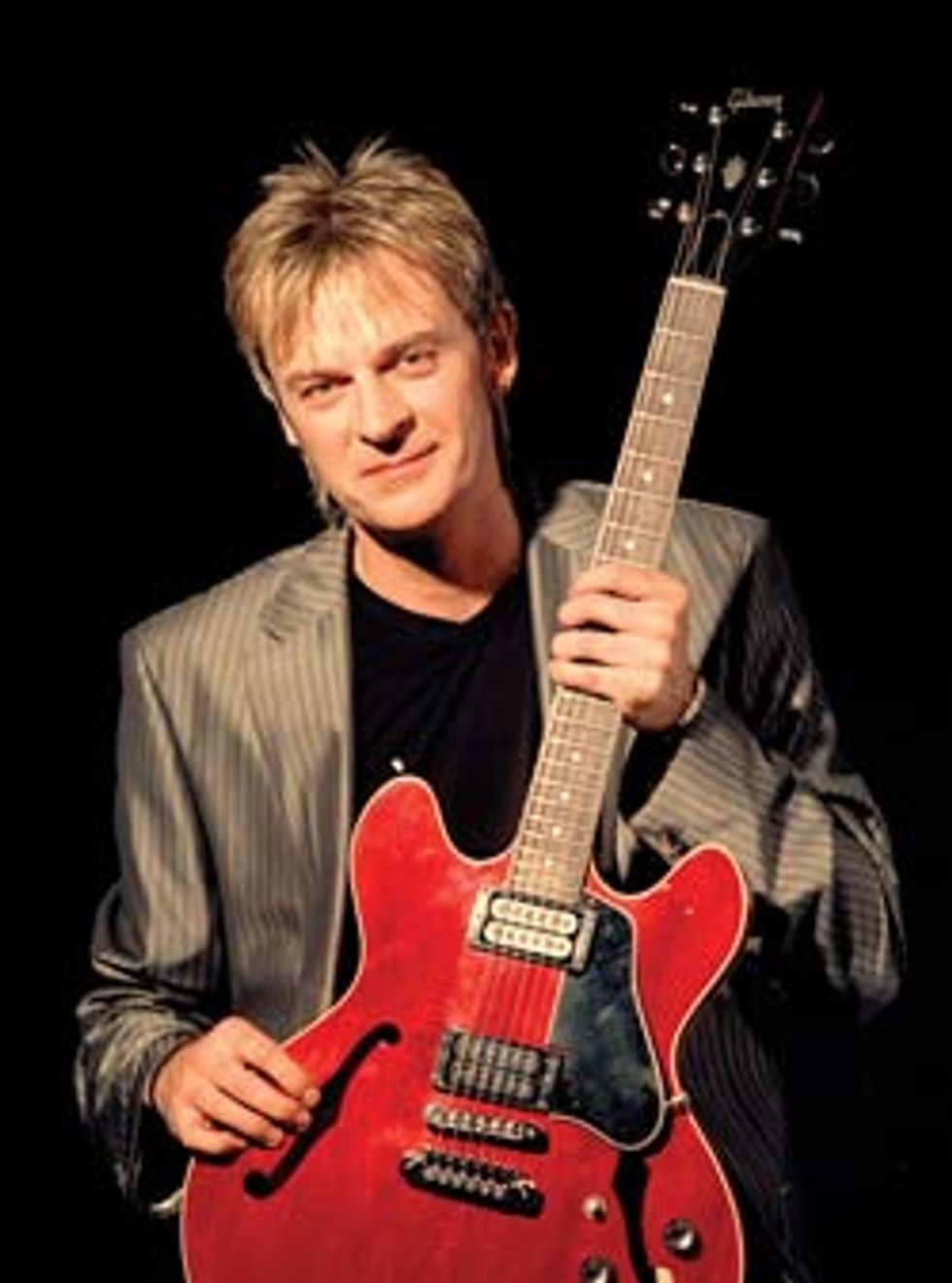 It changes… but I really feel drawn to the Gibson 300 series. I have an ES-335, a 345 and a 355, and I love them all. They sound good in any situation—very versatile guitars. I like the percussive attack, the natural sustain, the open tone, and also the look of those semi-acoustic guitars. A nice 345 simply feels more like the real thing to me than just a thin plank of wood.
But I also love my new Carvin CS6T. It was built for me at Carvin’s custom shop and it is a real high class instrument. As for amps, my Diezel VH4 sounds just amazing; I think that’s my favorite. Peter Diezel fine-tuned this amp to my playing style, attack and touch, so it’s perfect for me. My favorite effect pedal is the Rodenberg Tom Riepl Signature Overdrive. Actually, I wouldn’t call it an effect but a little preamp or tone generator. It doesn’t sound like an external overdrive pedal, but more like an integrated part of the amp. When I turn it on, it’s like switching to the overdrive channel of the amp. It’s very responsive and open sounding and the perfect match to the 345. So whenever I have to play through any rented amps (that’s mostly when I’m traveling), with this pedal I always have my tone in the pocket.
It changes… but I really feel drawn to the Gibson 300 series. I have an ES-335, a 345 and a 355, and I love them all. They sound good in any situation—very versatile guitars. I like the percussive attack, the natural sustain, the open tone, and also the look of those semi-acoustic guitars. A nice 345 simply feels more like the real thing to me than just a thin plank of wood.
But I also love my new Carvin CS6T. It was built for me at Carvin’s custom shop and it is a real high class instrument. As for amps, my Diezel VH4 sounds just amazing; I think that’s my favorite. Peter Diezel fine-tuned this amp to my playing style, attack and touch, so it’s perfect for me. My favorite effect pedal is the Rodenberg Tom Riepl Signature Overdrive. Actually, I wouldn’t call it an effect but a little preamp or tone generator. It doesn’t sound like an external overdrive pedal, but more like an integrated part of the amp. When I turn it on, it’s like switching to the overdrive channel of the amp. It’s very responsive and open sounding and the perfect match to the 345. So whenever I have to play through any rented amps (that’s mostly when I’m traveling), with this pedal I always have my tone in the pocket.
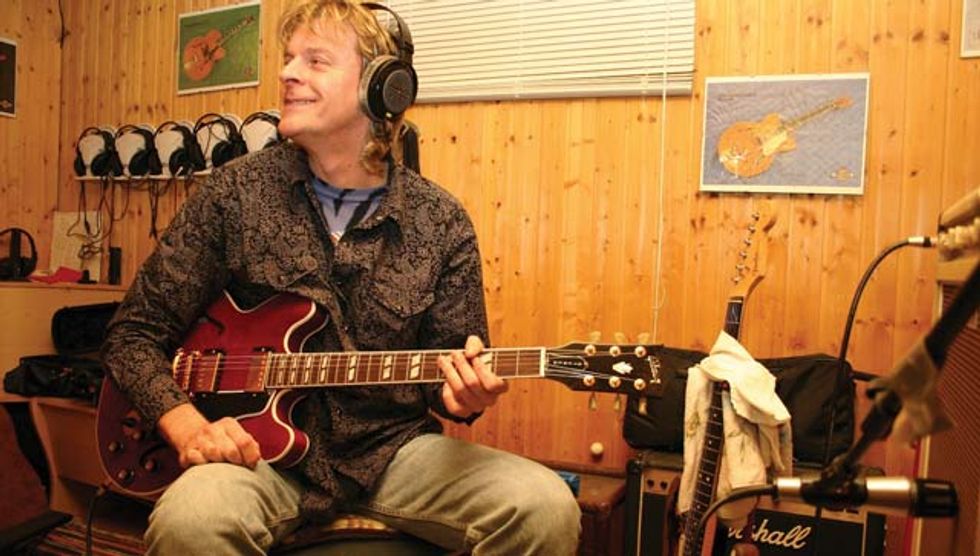
What’s the secret of your signature tone gear-wise?
There is no secret. It’s basically the ES-345, a good cable and the Diezel’s 3rd channel with the gain control halfway up. Or the same guitar with the Rodenberg Tomtone pedal and any tube combo amp. Well, I don’t dial in treble and presence as much as many others might do. I’d rather turn back the treble controls of the amps in order to get a smoother tone. I prefer a warm overdriven sound, and I like to hear all the little nuances of the fingers and the pick. Except for a small amount of reverb and subtle delay, I don’t use effects very often. I keep it simple, maybe that’s the secret. And the rest, I think, is heart and soul, fingers and touch, kind of…
I will always remember performing at the Ibanez booth during the Musikmesse in Frankfurt in 1999. I played three shows every day, doing some original tunes and Lee Ritenour’s “Rio Funk.” After the first day, I became pretty insecure about my choice of music, because all the other Ibanez artists were shredding at warp speed while I was doing my comparatively relaxed fusion and blues stuff. And every time I performed, there was a certain guy always watching me, a very sophisticated Japanese gentleman who seemed to like what I did. He turned out to be Mike Shimada of Ibanez, and on the last day of that fair, he said to me very softly and with this nice Japanese accent, “I’ve seen you play every day, and you were very good; so now we’ll build a signature guitar for you…” I couldn’t believe it, but it all came true! I was the first German guitarist to get his own Ibanez signature guitar, and the RG-PB-Tom is indeed a great instrument.
You use Rodenberg equipment a lot. Can you tell us more about it?
Rodenberg GAS pedals are all handmade using only the highest quality parts. I think these are the best overdrive pedals on the market. I didn’t know about these boxes until I read the booklet of Lee Ritenour’s album Smoke N Mirrors, where he mentioned using a GAS-808 pedal. I got curious and called Ulrich Rodenberg, who was very friendly and sent me two of his pedals to try out. I liked these overdrives immediately, and after a few more phone calls, Rodenberg suggested designing a signature pedal for me. I sent him a plan with all the specs I wanted and tried to explain exactly how it should sound. He understood exactly what I wanted, and approximately three months later the Tomtone overdrive hit the market. It’s the second-best-selling pedal of the whole Rodenberg line. Since then, I’ve endorsed Rodenberg products. There are only two official
Tom Riepl's Gearbox
|
If you had to go to a desert island and were only allowed to take one guitar, one amp and one stomp box with you, what would they be?
My Gibson ES-345, my Bad Cat combo, because it’s built like a tank and very reliable, which is important on a desert island, and my Rodenberg Tomtone signature pedal. I hope there’s electricity on that island…
What are your plans for the future?
I want to do another concept album in order to complete a trilogy that started with Hollymood and was followed by my latest CD, Radio Moonlight. I have a few good ideas already, but I’m still looking for a proper concept. I also want to improve my composing and arranging skills as well as following an even more free improvisation approach, which generally speaking means trying to avoid memorized licks. And I definitely plan to do more gigs. I’d love touring with a funky old-style R&B or soul band. Apart from that, I try to stay healthy and live a balanced life. Making too many plans in advance isn’t always good, because you’d only be disappointed if something you had planned won’t happen. So I better keep working, keep my eyes and ears open, and see what the future brings.
Is there anything you’d like to share with our readers about practicing and developing a unique style and tone?
If you’re starting to learn guitar and want to become a good player, the most important thing is to keep your ears open! Listen to every style you can and try to figure out what's going on. Listen to the blues! A lot of great guitar music is based on blues, and many famous rock, jazz, country and fusion players have those deep blues roots.
tomriepl.com
A sampling of Tom's Gear:
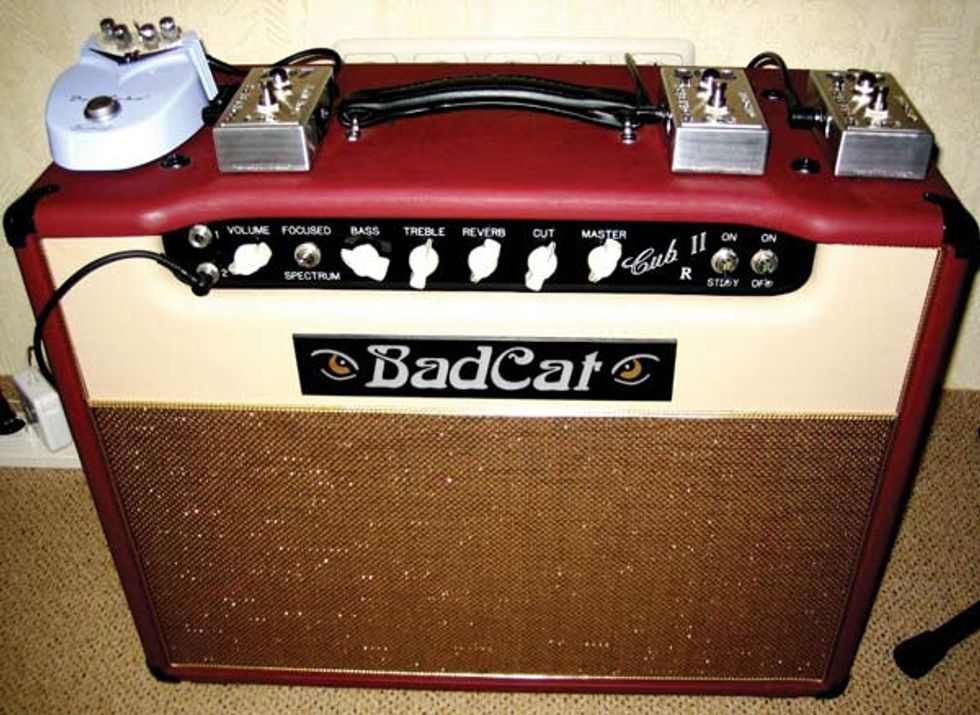
Badcat Cub 15R
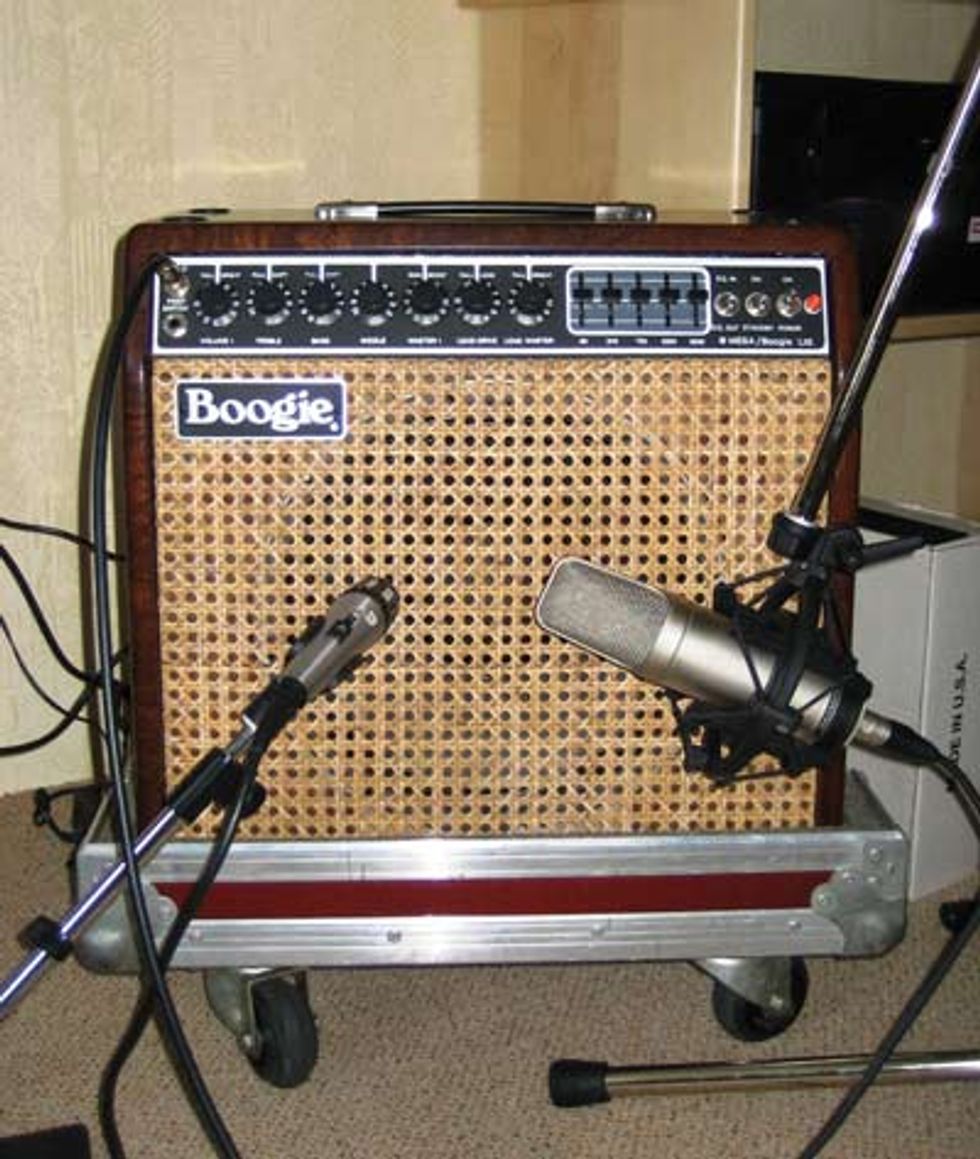
Mesa Boogie MK II (1983)
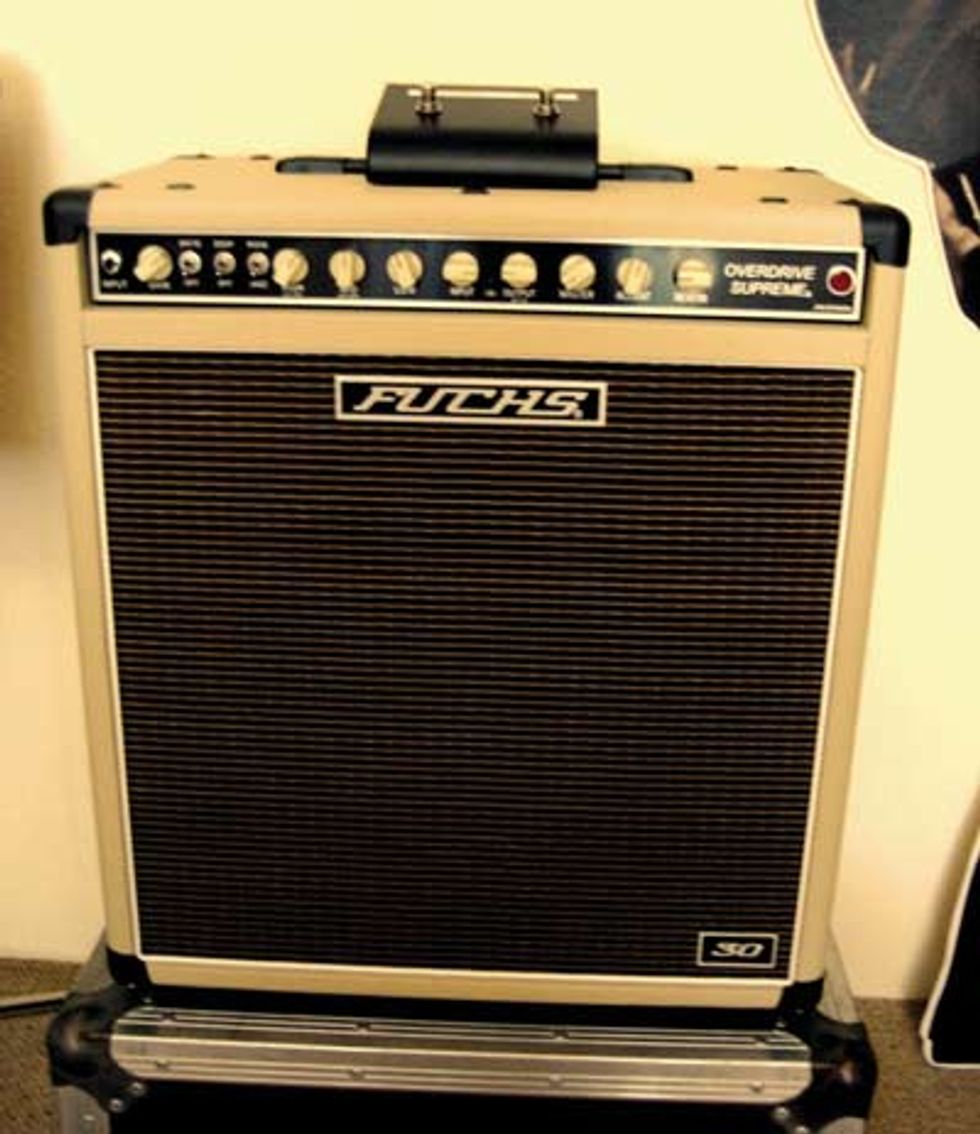
Fuchs Overdrive Supreme
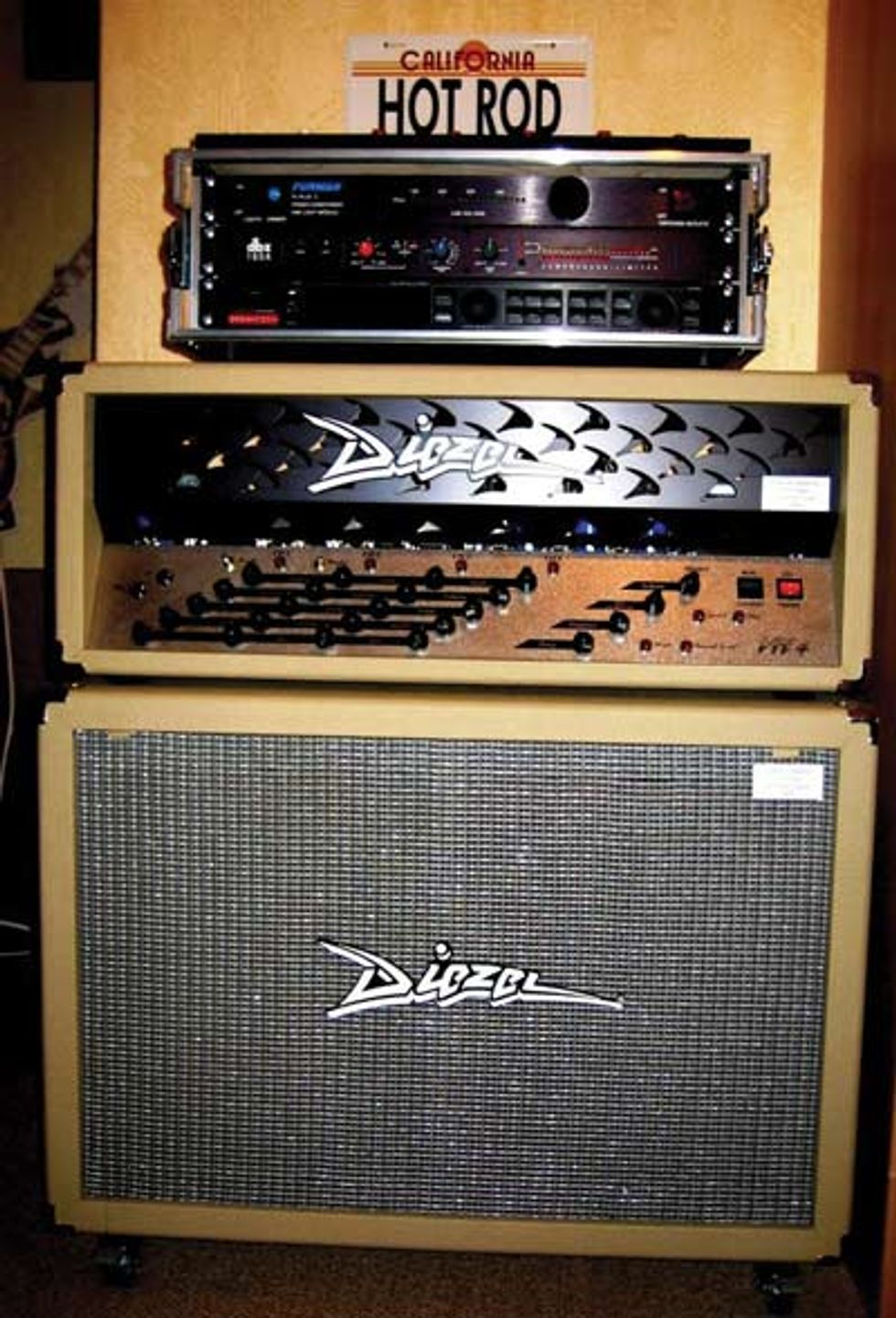
Diezel VH4 Custom
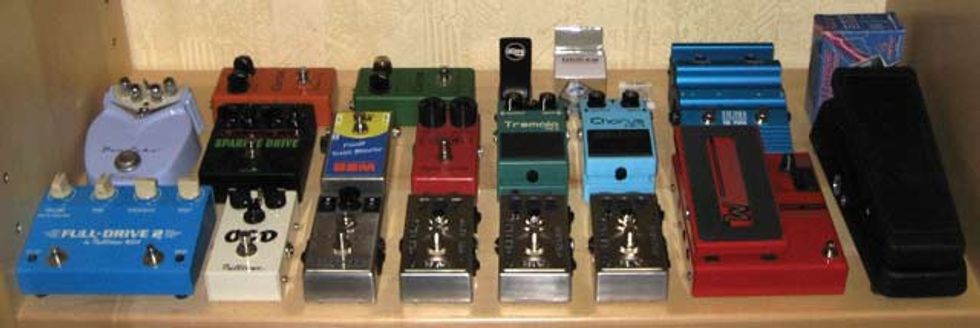
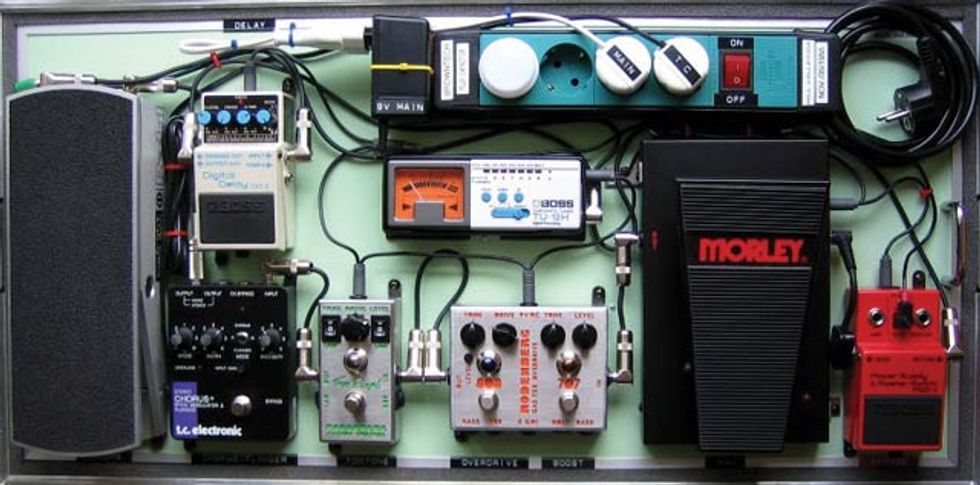 Tom's pedalboard
Tom's pedalboard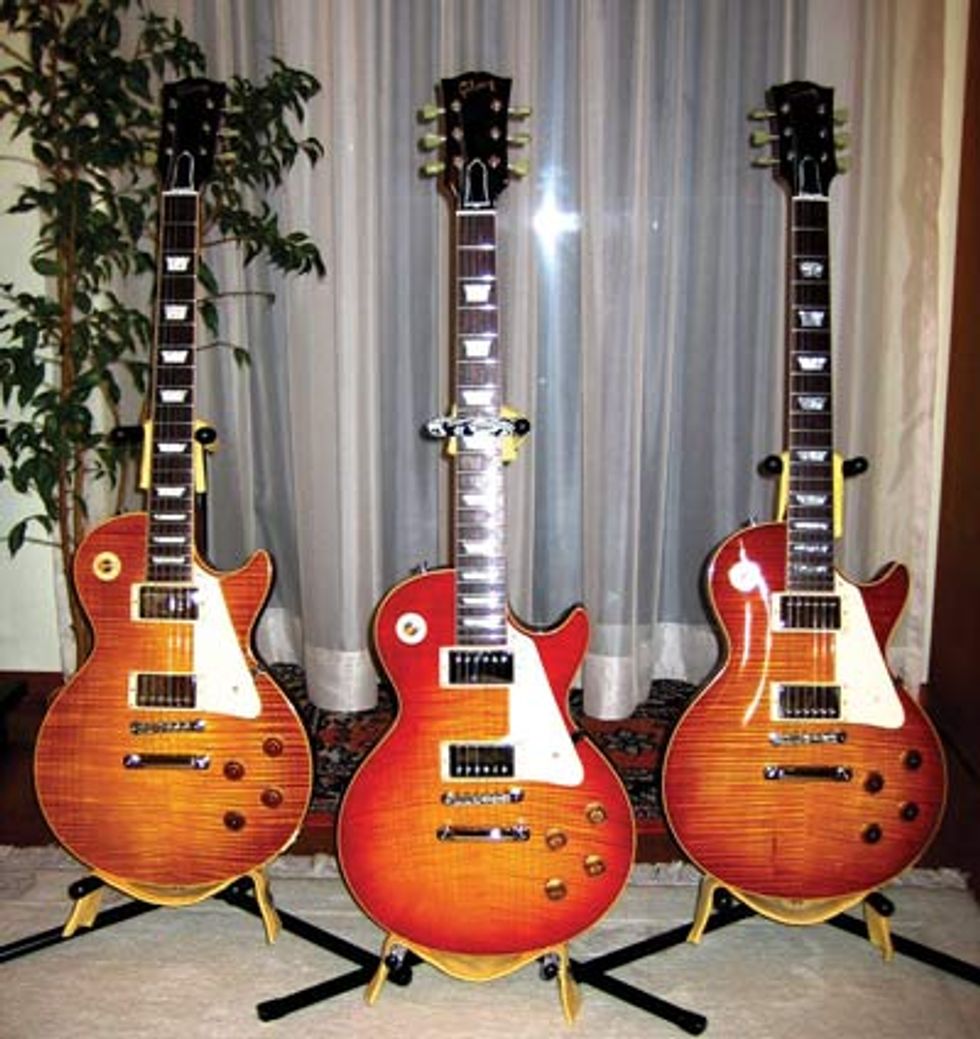
Tom's Les Pauls
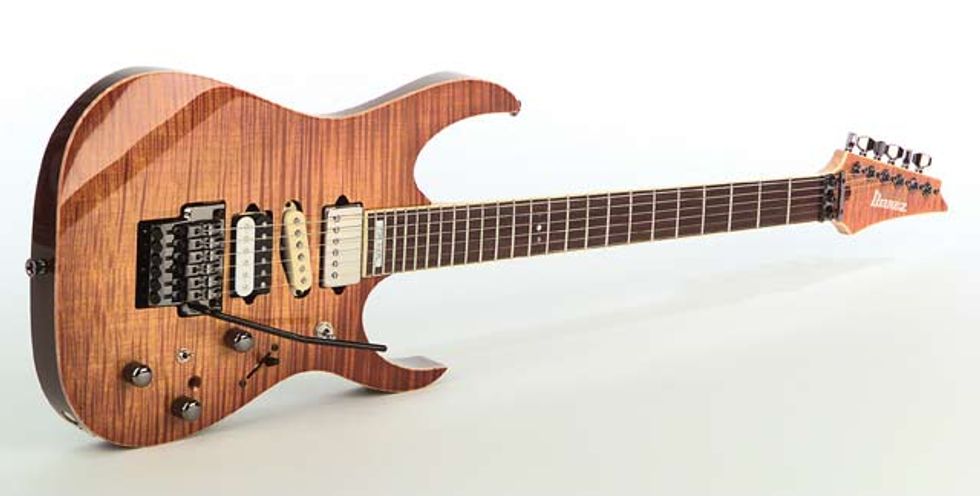
Tom's Signature Ibanez
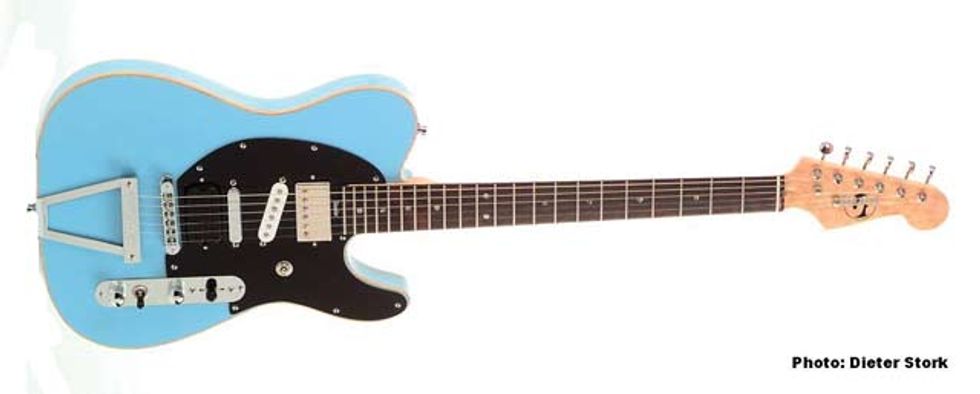
Staufer Dixiecaster

